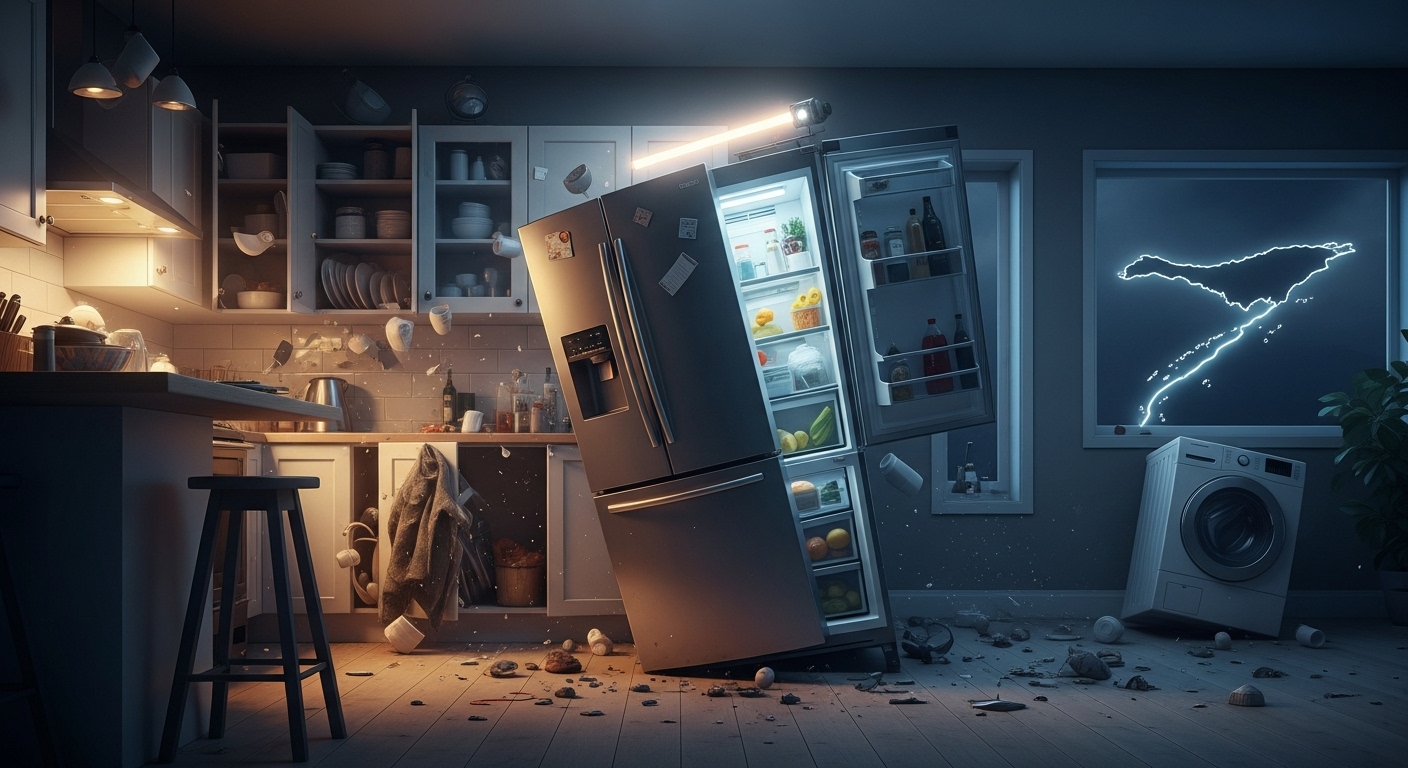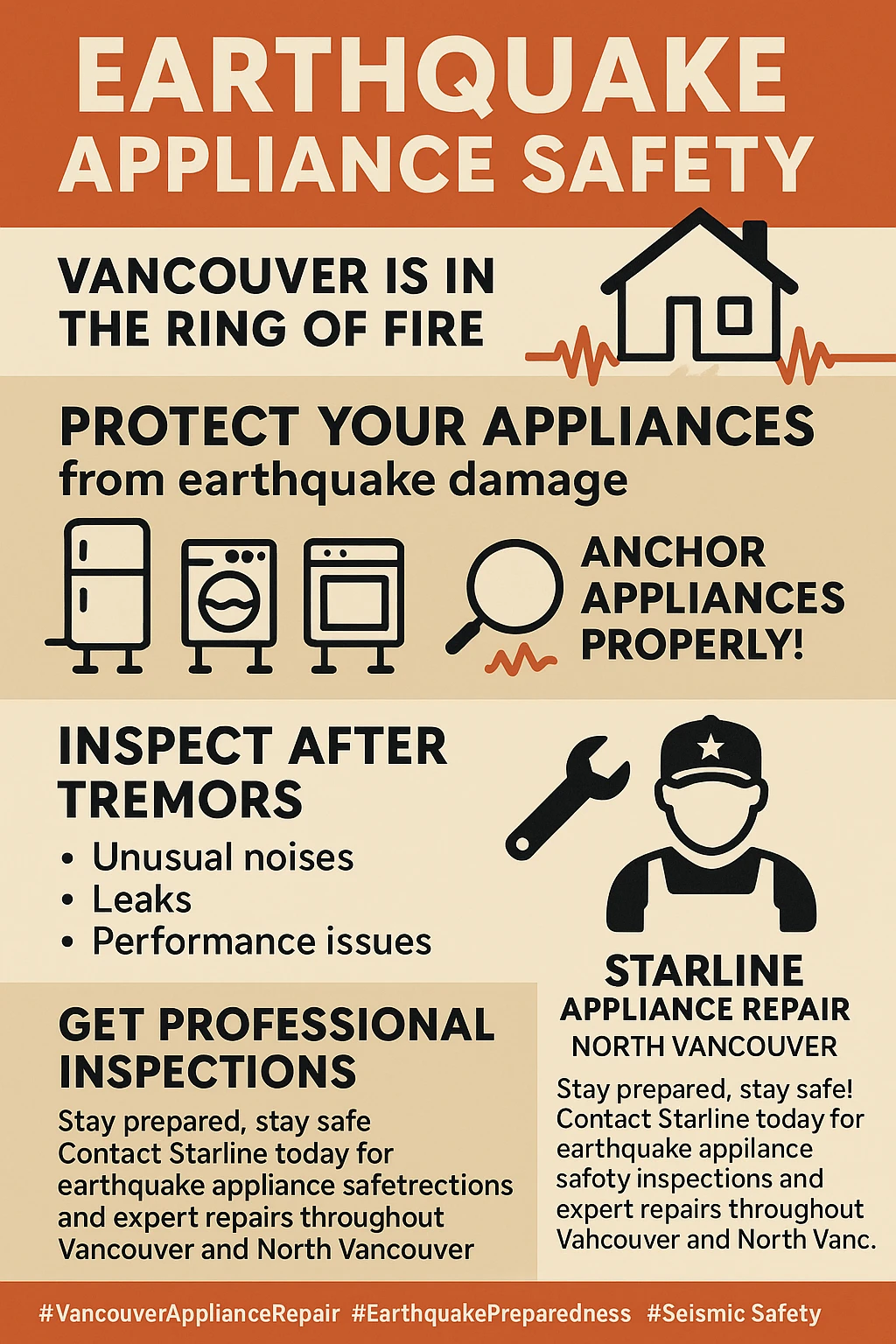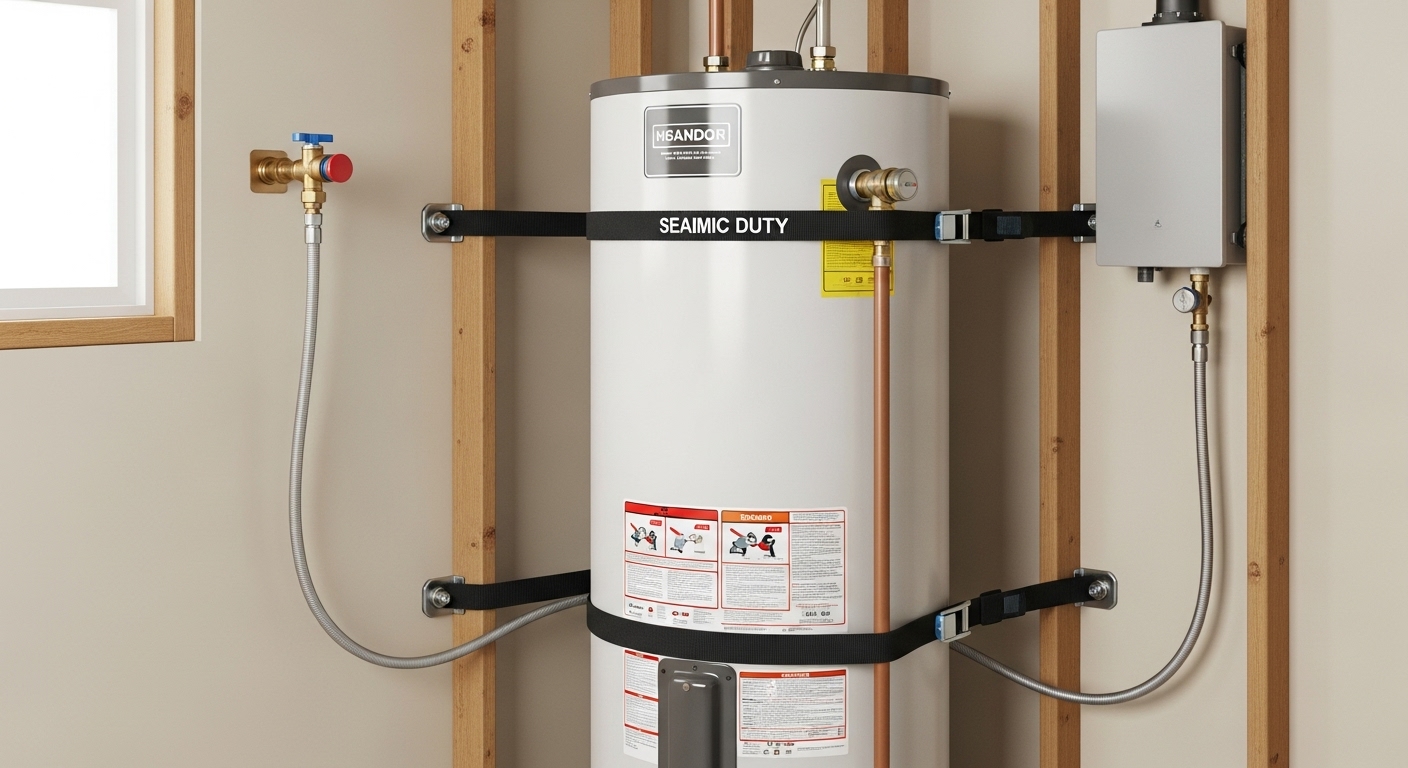Ever wondered how a major earthquake could turn your trusted home appliances into dangerous hazards or expensive paperweights? Vancouver’s location in the highly seismically active Cascadia Subduction Zone means that securing your appliances against earthquake damage isn’t just smart planning—it’s essential for your family’s safety and financial well-being. Vancouver homeowners face unique seismic risks that can transform everyday appliances into potential dangers during an earthquake. The Cascadia Subduction Zone, capable of producing magnitude 9.0+ earthquakes, poses a constant threat to the Lower Mainland. When these powerful seismic events occur, unsecured refrigerators can topple over, washing machines can rupture water lines, and gas appliances can develop dangerous leaks that lead to fires or explosions. Understanding how earthquakes affect your appliances and taking proper preventive measures can save thousands of dollars in damage while protecting your family from serious safety hazards.  The geological characteristics of Metro Vancouver create particularly challenging conditions for appliance protection. Built on a deep sedimentary basin, the region can amplify and prolong earthquake waves, making the shaking more intense and longer-lasting than areas built on solid bedrock. This amplification effect increases the risk to your home’s appliances, making proper anchoring and flexible connections even more critical for Vancouver residents.
The geological characteristics of Metro Vancouver create particularly challenging conditions for appliance protection. Built on a deep sedimentary basin, the region can amplify and prolong earthquake waves, making the shaking more intense and longer-lasting than areas built on solid bedrock. This amplification effect increases the risk to your home’s appliances, making proper anchoring and flexible connections even more critical for Vancouver residents.
Key Takeaways
- Vancouver faces significant earthquake risk from the Cascadia Subduction Zone, which can produce magnitude 9.0+ earthquakes with 4-6 minutes of intense shaking that affects all types of home appliances
- Unsecured appliances become dangerous projectiles during earthquakes, causing injuries and creating fire or flood hazards through broken gas lines and water connections
- Proper appliance anchoring using flexible straps, seismic-rated connectors, and professional installation can prevent most earthquake-related appliance damage and safety hazards
- Post-earthquake appliance inspection must focus on detecting gas leaks, electrical damage, water line breaks, and internal component shifting before resuming normal use
- Professional appliance repair services in Vancouver provide essential expertise for safely restoring earthquake-damaged appliances and ensuring proper code compliance

Vancouver’s Unique Seismic Risk and Appliance Vulnerability
Vancouver sits directly above one of North America’s most dangerous fault systems. The Cascadia Subduction Zone stretches from Northern California to British Columbia and has the potential to generate catastrophic earthquakes reaching magnitude 9.0 or higher. Scientists estimate a 7-15% probability of such an event occurring within the next 50 years, with geological evidence indicating that major earthquakes occur in this region approximately every 400-600 years.
The last known megathrust earthquake along the Cascadia Subduction Zone occurred in 1700, creating a tsunami that reached Japan’s coastline. When the next major earthquake strikes, Vancouver residents can expect 4-6 minutes of intense ground shaking that will test every aspect of home earthquake preparedness. This extended duration of violent movement poses exceptional risks to home appliances, particularly those that haven’t been properly secured.
Metro Vancouver’s geological foundation creates additional challenges for appliance protection. The region is built on a deep sedimentary basin that acts like a bowl, trapping and amplifying seismic waves. This geological feature can increase the intensity and duration of earthquake shaking compared to areas built on solid bedrock. The amplification effect means that appliances in Vancouver may experience more severe movement during an earthquake than similar appliances in other seismically active regions.
The most vulnerable appliances during earthquakes are those with high centers of gravity or significant weight. Refrigerators rank among the highest risk appliances because they can easily tip forward when their doors swing open during shaking. Their top-heavy design makes them particularly susceptible to falling, potentially crushing anyone nearby and creating secondary hazards through damaged electrical connections or blocked escape routes. 
Washing machines and dryers present unique challenges due to their tendency to “walk” or shift position during normal operation. During an earthquake, this movement becomes dramatically amplified, potentially causing these heavy appliances to slide across floors, tear loose from utility connections, and create dangerous obstacles. The internal components of washing machines, including the drum and suspension system, can suffer significant damage from the irregular movements experienced during seismic events.
Gas-powered appliances face additional risks due to their connection to the home’s natural gas system. Ranges, water heaters, furnaces, and dryers that rely on gas connections can develop dangerous leaks if their supply lines become stressed or damaged during earthquake movement. These leaks pose immediate fire and explosion risks, making proper flexible connections essential for all gas appliances in Vancouver homes.
How Earthquakes Damage Different Types of Appliances
Understanding the specific ways earthquakes affect different appliances helps homeowners prioritize their protection efforts and recognize potential post-earthquake hazards. Each type of appliance faces unique vulnerabilities based on its design, weight distribution, and utility connections.
Refrigerators suffer from multiple earthquake-related damage patterns that can render them unsafe or inoperable. The most common issue occurs when doors swing open during shaking, shifting the appliance’s center of gravity and causing it to tip forward. This tipping motion frequently damages door hinges, breaks internal shelving, and can crush the door seals that maintain proper temperature control. Internal components like compressors and cooling coils can also shift during violent shaking, leading to refrigerant leaks or complete system failure.
The electrical connections on refrigerators can suffer damage when the appliance rocks or shifts position. Power cords may be stressed or pulled from outlets, while internal wiring can be damaged by the movement of heavy components. Ice makers and water dispensers connected to household plumbing face additional risks from broken water lines, which can cause flooding and water damage throughout the home.
Washing machines experience a unique set of earthquake-related problems due to their heavy drums and complex mechanical systems. During normal operation, washing machines are designed to contain the movement of their internal drum, but earthquake shaking can overwhelm these containment systems. The drum can shift position, damaging the bearings, suspension rods, and drive mechanisms that keep the machine operating smoothly.
Water supply hoses on washing machines are particularly vulnerable during earthquakes. These hoses, which carry water under pressure, can rupture if the machine shifts position or if the connections experience stress from building movement. Burst water hoses can quickly flood laundry areas, potentially causing thousands of dollars in water damage to flooring, walls, and adjacent rooms.
Gas ranges and cooktops face specific challenges related to their fuel connections and heavy construction. The gas supply lines that feed these appliances can experience stress when the appliance shifts position during earthquake shaking. Rigid gas connections are particularly vulnerable to rupturing, creating immediate safety hazards through gas leaks that can lead to fires or explosions.
The heavy cast-iron grates and burner assemblies on gas ranges can shift during earthquakes, potentially misaligning components and affecting proper combustion. Glass cooktops are especially vulnerable to cracking or shattering from the vibrations, creating both safety hazards and rendering the appliance unusable. Control knobs and electronic ignition systems can also be damaged by the violent motion.
Water heaters represent one of the highest-risk appliances during earthquakes due to their potential for causing secondary disasters. When water heaters topple over, they can rupture both gas and water supply lines simultaneously, creating immediate fire and flood hazards. The large volume of hot water contained in these appliances can cause extensive damage when released, while damaged gas connections can lead to fires or explosions that threaten entire homes.
Electric water heaters face additional risks from power surges and electrical system damage during earthquakes. The heating elements and thermostats can be damaged by power fluctuations, while the electrical connections can be stressed by the movement of the heavy tank. Technical Safety BC protocols require professional inspection of all gas and electrical equipment after natural disasters to ensure safe operation.
Pre-Earthquake Appliance Protection and Anchoring Methods
Protecting appliances before an earthquake strikes requires a systematic approach that addresses both the physical anchoring of appliances and the flexibility of their utility connections. The investment in proper seismic protection typically costs a fraction of replacing damaged appliances and can prevent dangerous safety hazards during and after seismic events.
Flexible gas connections represent the most critical safety upgrade for gas-powered appliances in Vancouver. These specialized connectors allow appliances to move during earthquake shaking without breaking the gas supply line, preventing dangerous leaks that could lead to fires or explosions. Flexible gas connectors should be designed to accommodate 2-3 inches of movement in all directions and should include automatic shut  off valves.
off valves.
Post-Earthquake Appliance Inspection and Safety Checklist
After an earthquake, approach your appliances with caution. Prioritize safety by checking for immediate hazards before attempting to use any appliance. Follow this checklist to assess the situation:
- Check for Gas Leaks: The smell of rotten eggs is a clear sign of a natural gas leak. If you detect this odor, do not turn on any lights or use any electronics. Evacuate your home immediately and call FortisBC’s emergency line from a safe distance.
- Inspect Electrical Systems: Look for frayed wires, damaged power cords, or signs of sparking around outlets and appliances. If you see damage, turn off the power at the main circuit breaker and contact a licensed electrician.
- Examine Water Lines: Check all water supply hoses and connections for leaks, especially on your washing machine, dishwasher, and refrigerator. If you find a leak, shut off the main water supply to your home.
- Look for Physical Damage: Visually inspect appliances for signs of shifting, tipping, or damage to doors, seals, and internal components. Do not attempt to move heavy appliances that have shifted until you can do so safely.
- Listen for Unusual Noises: When you restore power, listen for any unusual buzzing, humming, or grinding sounds from your appliances. These could indicate internal damage.
If you have any doubts about the safety of an appliance, do not use it. It is always safer to wait for a professional inspection than to risk a fire, flood, or electrical hazard.
When to Call a Professional Appliance Repair Service
While some post-earthquake checks can be performed by homeowners, certain situations require professional expertise. Calling a qualified appliance repair technician in Vancouver is essential in the following scenarios:
- After Any Gas Leak: Even if you have turned off the gas, a professional must inspect the appliance and its connections before it can be safely used again.
- If an Appliance Tipped Over: A fallen appliance may have hidden structural damage or compromised internal components that are not visible.
- Visible Electrical Damage: Frayed wires or damaged electrical components require professional repair to prevent fire and shock hazards.
- Water Damage: If an appliance has been exposed to flooding, its electrical systems may be compromised and unsafe.
- Uncertainty: If you are unsure about the condition of an appliance, a professional assessment provides peace of mind and ensures your home remains safe.
Professional technicians have the tools and knowledge to safely diagnose and repair earthquake-related damage, ensuring that your appliances meet all safety codes and are restored to proper working order.
Frequently Asked Questions About Earthquake Appliance Safety
- How much does it cost to earthquake-proof my appliances?
- The cost is minimal compared to replacement costs. A set of seismic straps for a water heater or refrigerator typically costs between $20 and $50. Flexible gas connectors range from $30 to $60. Professional installation will add to the cost but ensures proper safety compliance.
- Can I install seismic straps and flexible connectors myself?
- While installing seismic straps can be a DIY project for those comfortable with tools, flexible gas line installation should always be performed by a licensed gas fitter to ensure safety and prevent leaks.
- Are newer appliances more earthquake-resistant?
- Not necessarily. While modern appliances may have improved construction, they are still vulnerable to tipping and connection damage if not properly secured. The key to safety is anchoring, not the age of the appliance.
- Will my home insurance cover earthquake damage to appliances?
- Standard home insurance policies in British Columbia do not cover earthquake damage. You must purchase a separate earthquake insurance policy to cover damage to your home’s structure and contents, including appliances.
Wrapping Up: Protecting Your Home and Family in Vancouver
Living in Vancouver means accepting the reality of seismic risk, but it doesn’t mean living in fear. By taking proactive steps to secure your home appliances, you can significantly reduce the risk of injury, property damage, and financial loss when the next earthquake strikes. Anchoring your refrigerator, strapping your water heater, and installing flexible gas connectors are small investments that provide invaluable protection for your family and your home. Don’t wait for the ground to shake—prepare your appliances today for a safer tomorrow.

